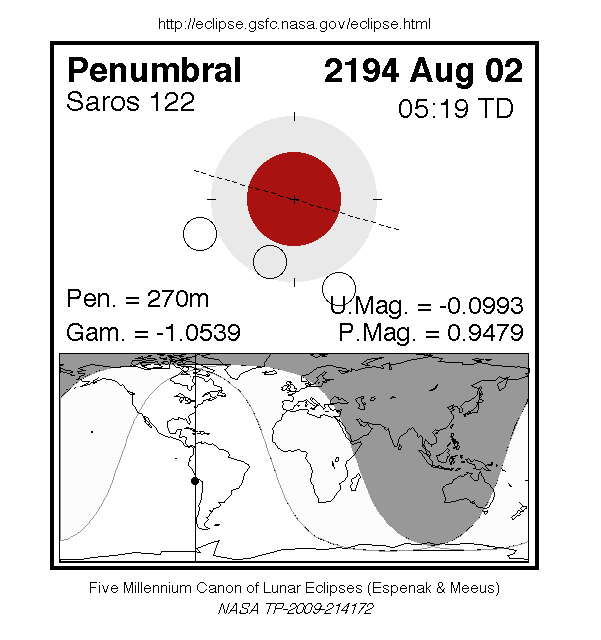A penumbral eclipse of the Moon occurs on Saturday 2 August, 2194 UT, with maximum eclipse at 05:11 UT. At maximum eclipse, 95% of the Moon's disc will be partially shaded by the Earth, which will cause a slight shadow gradient across its disc; this subtle effect may be visible to careful observers. No part of the Moon will be in complete shadow. The eclipse will last 4 hours and 30 minutes overall.
The penumbral eclipse lasts for 4 hours and 30 minutes.
Maximum eclipse is at 05:11:34 UT.
During this eclipse the Moon will be just 4 days past apogee, making it fairly small.
At maximum eclipse it will be 0.509° in apparent
diameter, which is 4.1% smaller than average.
The statistics page has information on the ranges of the sizes of
the Sun and Moon, and the Moon data page displays detailed
information on the Moon's key dates.
Interactive Map
This map shows the visibility of the eclipse at maximum eclipse,
when it will be visible within the bright area on the map. Note that
the map is approximate, and if you
are near the edge of the area of visibility, the moon will be very close
to the horizon and may not be practically visible.
You can use the zoom controls to zoom in and out, and pan to
see areas of interest. The green marker in the centre shows where
the Moon will be directly overhead at maximum eclipse.
The interactive map is currently not available.
Overview Map
This map sourced from NASA Goddard Space flight Center: GSFC Eclipse Web SiteGSFC Eclipse Web Site
The primary source of all the information on eclipses presented here at Hermit Eclipse. (NASA Goddard Space flight Center)
shows the visibility of the eclipse. (Click on it for the
full-sized version.)
Eclipse Season and Saros Series
This eclipse season contains 2 eclipses:
This is the 66th eclipse in lunar Saros series 122.The surrounding eclipses in this Saros series are:
This Saros series, lunar Saros series 122,
is linked to solar Saros series 129. The
nearest partner eclipses in that series are:
Eclipse Parameters
| UT Date/time (max) | 05:11:34 on 2 Aug UT |
TDT Date/time (max) | 05:18:42 on 2 Aug TDT |
| Saros Series | 122 |
Number in Series | 66 |
| Penumbral Magnitiude | 0.9479 |
Central Magnitiude | -0.0993 |
| Gamma | -1.0539 |
Path Width (km) | |
| Delta T | 7m08s |
Error | ± 4m28s (95%) |
| Penumbral Duration | 4h30m |
Partial Duration | |
| Total Duration | |
| |
| Partial Rating | |
Total Rating | |
| Sun Distance | 151856942 km (98.5%) |
Moon Distance | 397088 km (80.9%) |
| Sun Diameter | 0.525° |
Moon Diameter | 0.501° - 0.509° |
| Apogee | 16:39 on 28 Jul UT |
Perigee | 12:39 on 13 Aug UT |
Note that while all dates and times on this site (except
where noted) are in UT, which is within a second of civil time,
the dates and times shown in NASA's eclipse listingsGSFC Eclipse Web Site
The primary source of all the information on eclipses presented here at Hermit Eclipse. (NASA Goddard Space flight Center)
are in the TDT timescale.
The Sun and Moon distances are shown in km, and as a
percentage of their minimum - maximum distances; hence 0%
is the closest possible (Earth's perihelion, or the
Moon's closest possible perigee) and 100% is
the farthest (aphelion, the farthest apogee).
The statistics page has information on the ranges of sizes
of the Sun and Moon, and the Moon data page displays detailed
information on the Moon's key dates.
Data last updated: 2015-06-21 22:11:47 UTC.

